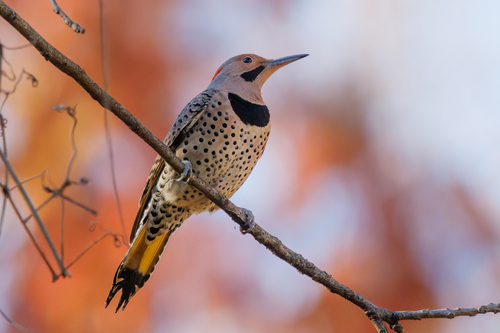
Northern Flicker
The Northern Flicker (Colaptes auratus) is a medium-sized woodpecker native to North America, known for its distinctive appearance and behavior. Unlike most woodpeckers, flickers often forage on the ground, searching for ants and beetles. They play a crucial role in controlling insect populations and are known for their undulating flight pattern and loud, ringing calls. The species holds cultural significance in some Indigenous communities, often associated with certain ceremonial practices and beliefs.
28-36 cm
Length
42-54 cm
Wingspan
Least Concern
Conservation Status
Distribution
North America, ranging from Alaska and Canada south to Central America and Cuba. Some populations are migratory, moving south for the winter, while others are resident year-round. Their altitudinal range extends from sea level to high mountain forests.
Lifespan
Up to 9 years in the wild, though the average is likely lower.
Northern Flicker's Habitat
Habitat Types
Open woodlands, Forest edges, Parks, Savannas, Residential areas
Climate Zones
Temperate, Subtropical, Tropical
Adaptations
Northern Flickers possess strong claws for gripping tree bark and a long, barbed tongue for extracting insects from crevices. Their slightly curved bill is also well-suited for ground foraging.
Variations
There are several recognized subspecies, including the 'Yellow-shafted Flicker' of the east and the 'Red-shafted Flicker' of the west, distinguished by the color of their feather shafts and underparts.
Appearance
Breeding Plumage
Plumage is generally similar year-round. However, breeding birds may have slightly brighter colors.
Seasonal Feather Changes
Minimal seasonal variation.
Sex Based Plumage Differences
Males typically have a black or red 'mustache' stripe, which is absent or less prominent in females. Yellow-shafted Flickers have a red nape crescent, while Red-shafted flickers do not
Notable Features
Brownish overall with black barring on the back and wings., Black bib on the chest., White rump patch visible in flight., Brightly colored feather shafts (yellow or red depending on subspecies).
Diet and Feeding
Primary Foods
Ants, Beetles, Other insects, Fruits, Berries, Seeds, Nuts
Foraging Behavior
Primarily forages on the ground, probing with its bill to find ants and other insects. It also gleans insects from tree bark and occasionally catches insects in flight.
Specializations
The long, sticky, barbed tongue is specialized for extracting ants from their tunnels.
Seasonal Diet Variations
Diet shifts seasonally. Insects are more prevalent in the diet during the warmer months, while fruits, berries, and seeds are more important in the fall and winter.
Behavior
Social Structure
Generally solitary or in pairs during the breeding season. May form small flocks during migration and in winter.
Communication
Loud, ringing call ('wick-wick-wick' or 'kyeer')., Drumming on resonant surfaces (trees, utility poles)., Visual displays (head-bobbing, tail-flicking).
Migration
Many northern populations are migratory, flying south for the winter. Migration is often triggered by cold weather and food scarcity.
Territorial or Group Behaviors
Males defend territories during the breeding season through vocalizations, drumming, and sometimes physical confrontations.
Conservation
Threats
Habitat loss (deforestation, urbanization), Pesticide use (affecting insect prey), Collisions with buildings and vehicles
Protection Programs
Migratory Bird Treaty Act (protection in the US), Habitat conservation efforts (e.g., preserving mature forests)
Local National Laws
Protected under various state and provincial wildlife regulations.
Population Trend
Generally stable, although some local populations may be declining.
Population Estimates
Global population estimated to be around 9 million individuals.
Interesting Facts
Northern Flickers are one of the few woodpecker species that frequently forage on the ground.
This behavior is related to their preference for ants, which make up a significant portion of their diet.
They have an undulating flight pattern
Alternating between flapping and gliding, creating a rollercoaster-like motion in the air.
Yellow-shafted and Red-shafted Flickers were once considered separate species.
They hybridize where their ranges overlap, leading to their reclassification as one species.
Faqs about Northern Flicker
What do I do if I find a baby Northern Flicker?
If the bird appears injured or truly orphaned, contact a local wildlife rehabilitator. It's best to leave uninjured fledglings alone, as their parents are likely nearby. Consult a professional for expert advice.
Why is a Northern Flicker drumming on my house?
They may be trying to attract a mate, establish territory, or search for insects. The drumming is usually harmless, but if it's causing damage, you can try deterrents like reflective tape or bird netting.
How can I attract Northern Flickers to my yard?
Provide a source of fresh water, plant native trees and shrubs that provide food and shelter, and consider putting up a nest box suitable for woodpeckers. Avoid using pesticides.
Copyright @ Nature Style Limited. All Rights Reserved.
 English
English